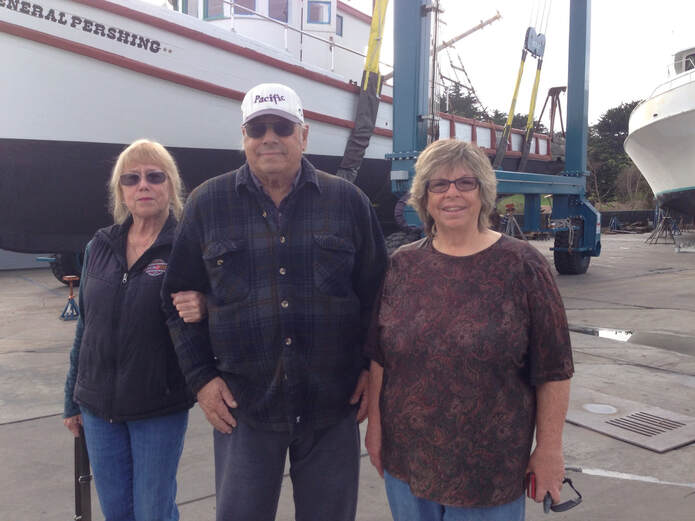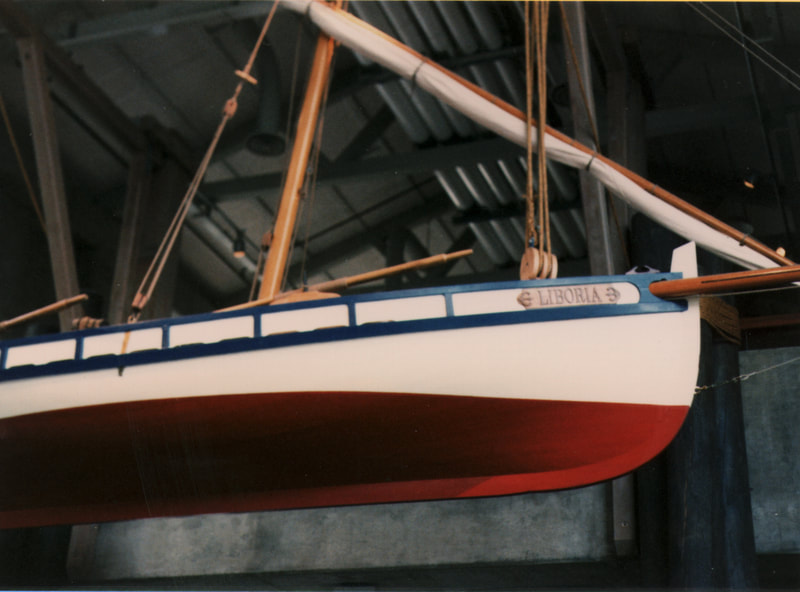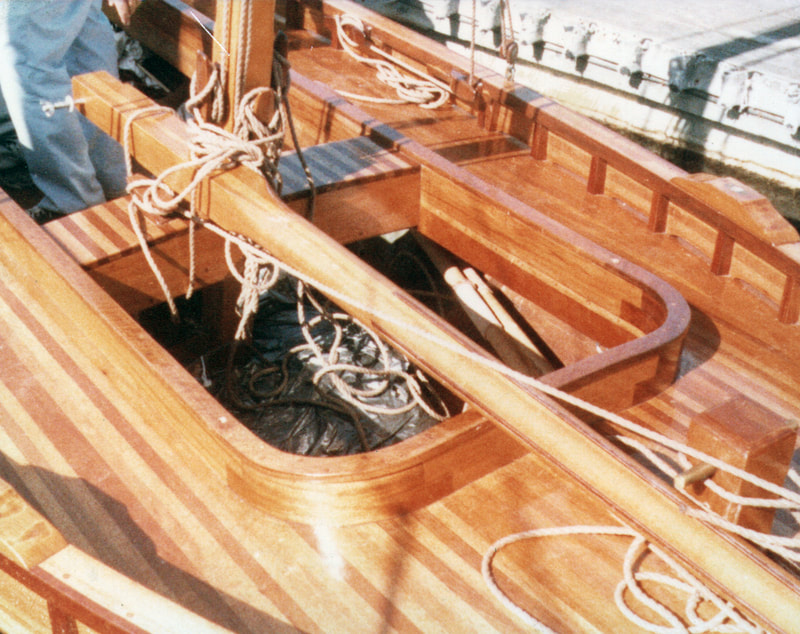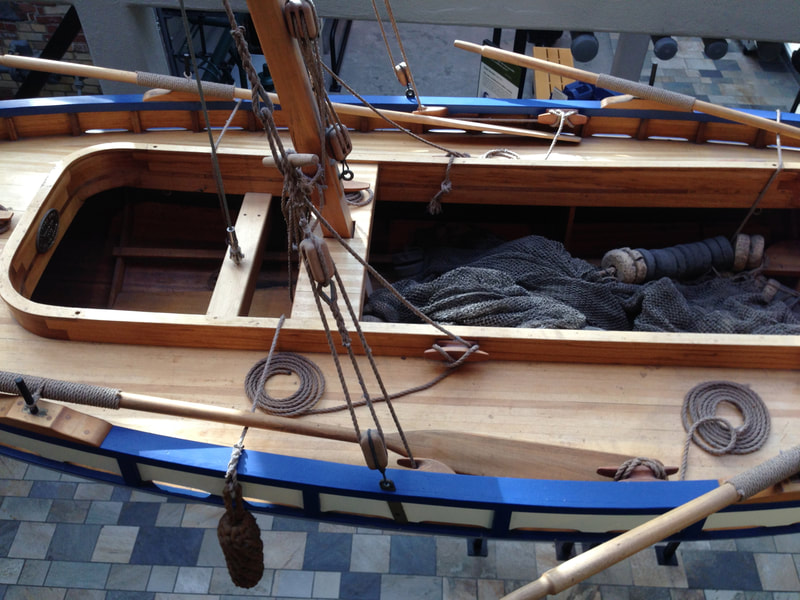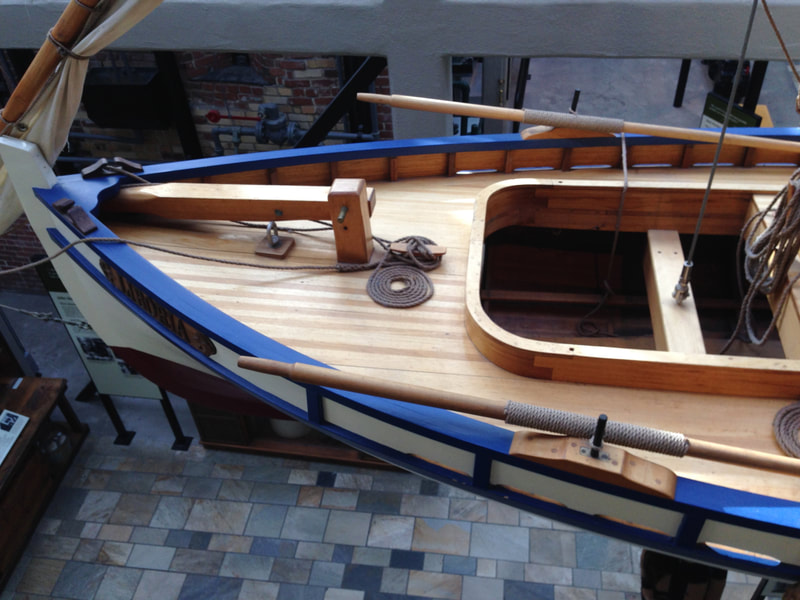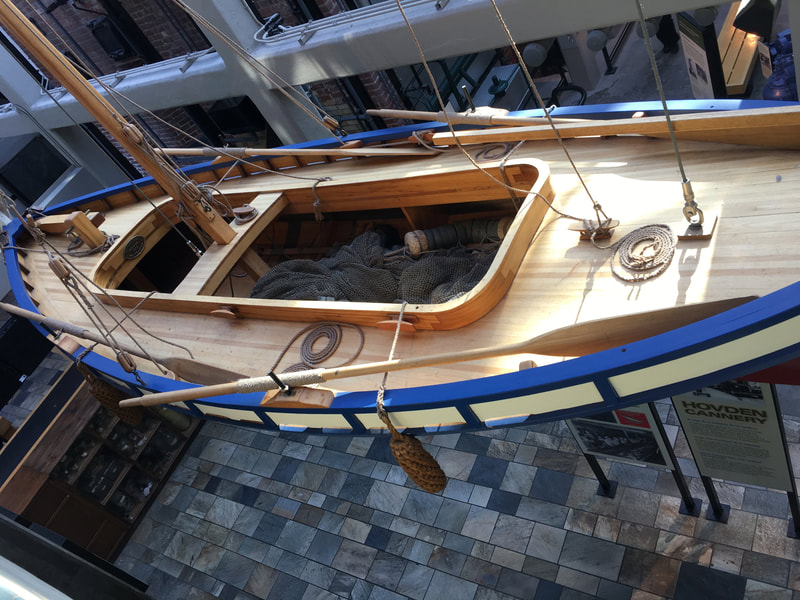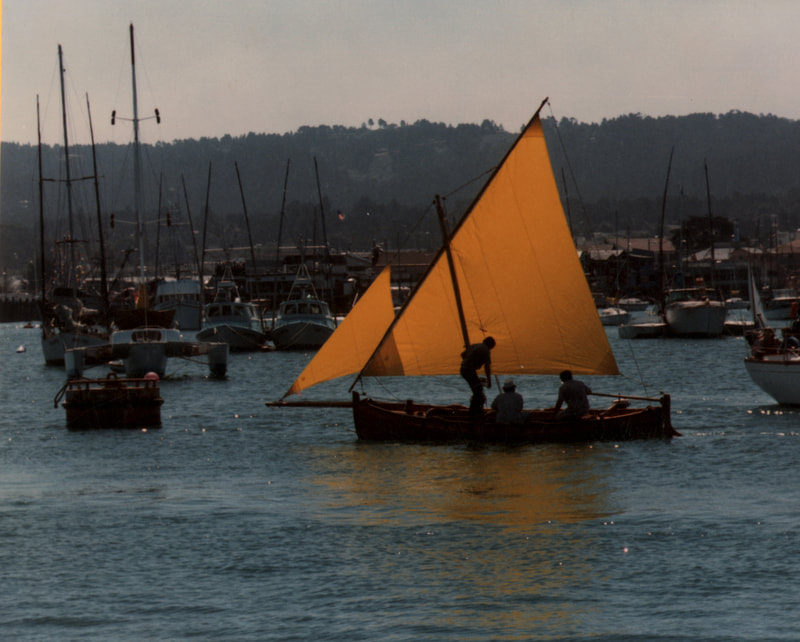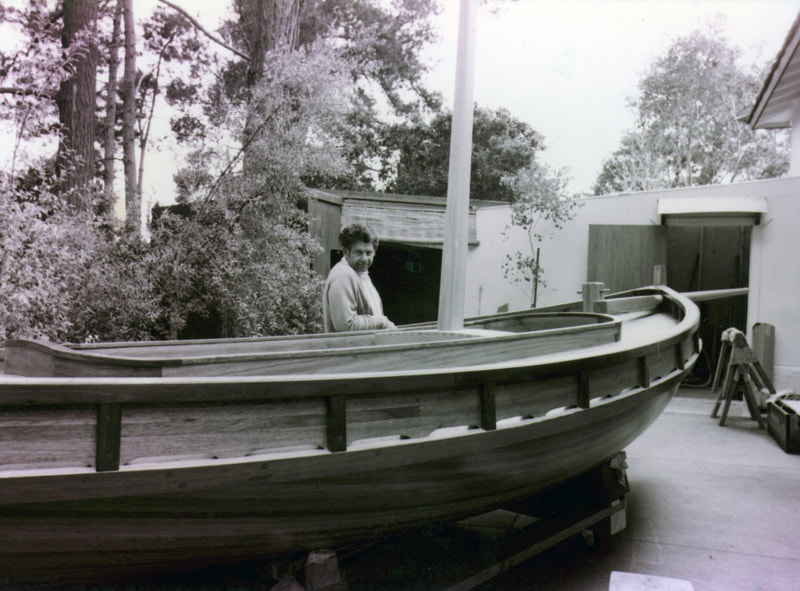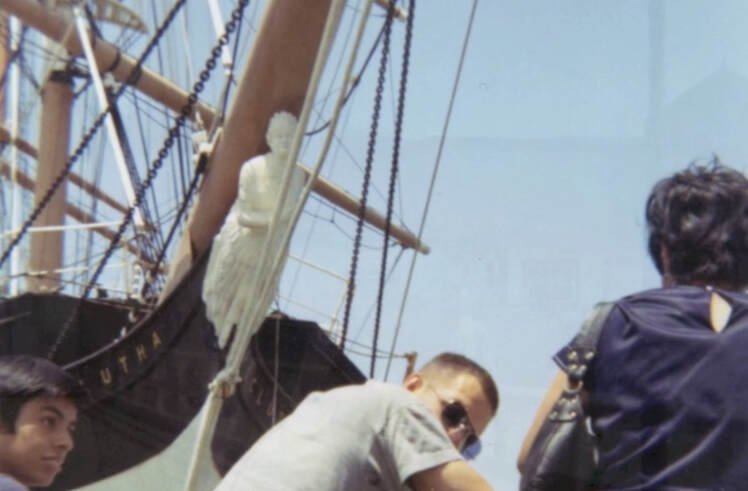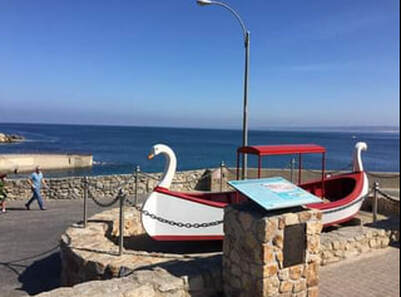Dedication
Frank Siino’s presentation of Felucca “Liboria” to the Monterey Bay Aquarium
On October 19, 1984
“I first met David Packard when he, his daughter Julie and their exhibit staff came to my mother’s back yard in Monterey to view my boat Liboria. This was about a year ago (1983), not long after I had launched her and spent several days having the time of my life sailing and rowing the Monterey Bay. Mr. Packard and company were obviously impressed with what they had witnessed that day because the Liboria now shares a very honorable position near the entrance way of the very impressive Monterey Bay Aquarium. The Aquarium staff did an extremely commendable job in recreating the wharf scene of the 1875-1895 eras with davits, pilings, etc. Very much like those in Monterey, Santa Cruz and San Francisco. My contribution of several hundreds of hours in the construction of this Felucca replica is reciprocated by the honor that has been bestowed upon me in just having her be where she is. If there is such an organization as the Boat Builders Hall of Fame, I feel like I was inducted. However, this honor is such magnitude that I would want the Liboria to be a tribute and memorial to all the boat builders of my time. Namely, to my brother Ray with whom I was a partner of the Moss Landing Boat Yard as well as the Monterey Boat Works for many years. Then there was our father Angelo, with whom we did our apprenticeship (no easy task). We go back to Gus Smith and beyond to the partnership of Piersen and Cochran, founders of Monterey Boat Works. I would also mention the part-time fishermen-boat builders such as the Crivellos, Russos and Aliotos, all fine craftsmen of yesteryear.
Thank you Mr. Packard, family and Foundation for allowing me and the boat builders of my time, to share with you a place in history.”
"The Last Monterey Felucca" video is now available for showing to groups in the Monterey Area.
Frank Siino’s presentation of Felucca “Liboria” to the Monterey Bay Aquarium
On October 19, 1984
“I first met David Packard when he, his daughter Julie and their exhibit staff came to my mother’s back yard in Monterey to view my boat Liboria. This was about a year ago (1983), not long after I had launched her and spent several days having the time of my life sailing and rowing the Monterey Bay. Mr. Packard and company were obviously impressed with what they had witnessed that day because the Liboria now shares a very honorable position near the entrance way of the very impressive Monterey Bay Aquarium. The Aquarium staff did an extremely commendable job in recreating the wharf scene of the 1875-1895 eras with davits, pilings, etc. Very much like those in Monterey, Santa Cruz and San Francisco. My contribution of several hundreds of hours in the construction of this Felucca replica is reciprocated by the honor that has been bestowed upon me in just having her be where she is. If there is such an organization as the Boat Builders Hall of Fame, I feel like I was inducted. However, this honor is such magnitude that I would want the Liboria to be a tribute and memorial to all the boat builders of my time. Namely, to my brother Ray with whom I was a partner of the Moss Landing Boat Yard as well as the Monterey Boat Works for many years. Then there was our father Angelo, with whom we did our apprenticeship (no easy task). We go back to Gus Smith and beyond to the partnership of Piersen and Cochran, founders of Monterey Boat Works. I would also mention the part-time fishermen-boat builders such as the Crivellos, Russos and Aliotos, all fine craftsmen of yesteryear.
Thank you Mr. Packard, family and Foundation for allowing me and the boat builders of my time, to share with you a place in history.”
"The Last Monterey Felucca" video is now available for showing to groups in the Monterey Area.
The ship was transferred to the National Park Service in 1978, this photo was taken in 1970 by E.G. Martinez, San Francisco CA
The Balclutha page on the website for the National Park Service. San Francisco, CA (https://www.nps.gov/places/sailing-ship-balclutha.htm) describes much of this vessel’s history mentioning in passing that this ship was wrecked on a reef in 1904 in the port town of Karluk on Kodiak Island, Alaska.
What is not mentioned was that Gaetano E. Seeno supervised and is credited for the rescue of this vessel. If he was not in Alaska in 1904 and didn’t have the incredible skills needed to rescue this vessel, the Maritime Historical Park would not have been able to share this history with thousands of students over the years. Gaetano comes from a family of very talented boat builders, one of which was his brother Angelo. Angelo, age 14, was just arriving from Isola delle Femmine, Sicily in 1903 when Gaetano was in Alaska.
In 1930 Angelo asked his master boat builder brothers Gaetano and Francesco as well as his father Erasmo to help him build the largest boat of his career, the General Pershing.
The following documentation is presented courtesy of research by Angelo Ghio and Earl Hohlmayer from their book, “If You Take Care of ‘Em, They Will Last!”
To read a very detailed account of the rescue click on THE RESCUE OF THE BALCUTHA below.
What is not mentioned was that Gaetano E. Seeno supervised and is credited for the rescue of this vessel. If he was not in Alaska in 1904 and didn’t have the incredible skills needed to rescue this vessel, the Maritime Historical Park would not have been able to share this history with thousands of students over the years. Gaetano comes from a family of very talented boat builders, one of which was his brother Angelo. Angelo, age 14, was just arriving from Isola delle Femmine, Sicily in 1903 when Gaetano was in Alaska.
In 1930 Angelo asked his master boat builder brothers Gaetano and Francesco as well as his father Erasmo to help him build the largest boat of his career, the General Pershing.
The following documentation is presented courtesy of research by Angelo Ghio and Earl Hohlmayer from their book, “If You Take Care of ‘Em, They Will Last!”
To read a very detailed account of the rescue click on THE RESCUE OF THE BALCUTHA below.
The Rescue of the Balcutha
Gaetano E. Seeno saves Balclutha
Boat builder Gaetano E. Seeno supervised the work in saving Balclutha, the famous square-rigged vessel owned by the San Francisco Maritime Museum, when it was wrecked in 1904 in Alaska. Seeno, a long-time Black Diamond (Pittsburg, CA) resident, was highly regarded as a man of unequaled qualifications. A versatile craftsman as equally at home building boats or constructing a cannery or patching up a damaged ship, he was a favorite for years throughout the building trades. His services were repeatedly used in the improvements and expansions of cannery facilities in the remote Alaskan territories.
. . . In 1904 the vessel, in command of Capt. Bernard Bremar, was on its way to Karluk cannery. In heavy fog she ran on to a reef near Kodiak Island. The vessel was hard aground listing at a 45% angle. The cargo and all 100 persons aboard survived the accident.
William Munn, a superintendent of the Alaska Packers Cannery at Atilak arrived to make assessment of the damage and possible salvage of the Balclutha. To determine how much was involved in refloating and recovery., an opinion was made covering all aspects of possible trouble. A final assessment and assurance completed the analysis for Mann, and it was with confidence and the backup of nearby men and equipment of the Packers that he offered Capt. Bremar $500 for the Balclutha where she lay. Bremar acted in the best interest of his owners in making a final judgment to accept the offer. He could hardly be criticized for this acceptance for the Balclutha was considered badly wrecked.
The Alaska Packers merely sent the needed gear to start the salvage operations. Cargo shuttles to Karluk continued without let-up. Seeno was at Karluk Cannery when news of the Balclutha arrived. His knowledge of boat building in Black Diamond worked miracles in the stricken ship’s recovery.
They used a hodge-podge of temporary work practices, defying the sea. They concluded that the best weapon against the sea, to wrest this ship from the reef’s hold, was to use the power of a full moon flood tide. Small holes were plugged as best they could. Gaping holes were sheathed (boarded) and covered with heavy canvas and sheathed over again and braced, shored, bolted or nailed against anything that was firm.
These stubborn individualists supervised by Seeno provided the skills, manpower and ingenuity to patch and plug all leaks and brought pumps that siphoned off the salt water from her insides at low tide. All the weakened portions of the vessel were strengthened. Empty barrels were placed inside for buoyancy and empty barges were fastened to Balclutha’s side.
At high flood tide she floated free and was towed to a local shipyard for repairs. With Seeno’s expertise and $500, the Alaska Packers had a new ship in their fleet. They renamed her Star of Alaska.
Each year in April, the Star of Alaska sailed from Alameda, CA carrying cannery workers, fishermen and supplies until September. Early in that month she would start the 2,400-mile voyage back to San Francisco Bay loaded with cases of canned salmon.
. . . the Star of Alaska was modified to make berths for 200 Italian fishermen and Chinese cannery workers that made the trip to Alaska and back. The Alaska Packers in1930 retired the vessel
The Star of Alaska is now restored and under its original name of Balclutha is based at San Francisco Maritime National Historical Park.
Boat builder Gaetano E. Seeno supervised the work in saving Balclutha, the famous square-rigged vessel owned by the San Francisco Maritime Museum, when it was wrecked in 1904 in Alaska. Seeno, a long-time Black Diamond (Pittsburg, CA) resident, was highly regarded as a man of unequaled qualifications. A versatile craftsman as equally at home building boats or constructing a cannery or patching up a damaged ship, he was a favorite for years throughout the building trades. His services were repeatedly used in the improvements and expansions of cannery facilities in the remote Alaskan territories.
. . . In 1904 the vessel, in command of Capt. Bernard Bremar, was on its way to Karluk cannery. In heavy fog she ran on to a reef near Kodiak Island. The vessel was hard aground listing at a 45% angle. The cargo and all 100 persons aboard survived the accident.
William Munn, a superintendent of the Alaska Packers Cannery at Atilak arrived to make assessment of the damage and possible salvage of the Balclutha. To determine how much was involved in refloating and recovery., an opinion was made covering all aspects of possible trouble. A final assessment and assurance completed the analysis for Mann, and it was with confidence and the backup of nearby men and equipment of the Packers that he offered Capt. Bremar $500 for the Balclutha where she lay. Bremar acted in the best interest of his owners in making a final judgment to accept the offer. He could hardly be criticized for this acceptance for the Balclutha was considered badly wrecked.
The Alaska Packers merely sent the needed gear to start the salvage operations. Cargo shuttles to Karluk continued without let-up. Seeno was at Karluk Cannery when news of the Balclutha arrived. His knowledge of boat building in Black Diamond worked miracles in the stricken ship’s recovery.
They used a hodge-podge of temporary work practices, defying the sea. They concluded that the best weapon against the sea, to wrest this ship from the reef’s hold, was to use the power of a full moon flood tide. Small holes were plugged as best they could. Gaping holes were sheathed (boarded) and covered with heavy canvas and sheathed over again and braced, shored, bolted or nailed against anything that was firm.
These stubborn individualists supervised by Seeno provided the skills, manpower and ingenuity to patch and plug all leaks and brought pumps that siphoned off the salt water from her insides at low tide. All the weakened portions of the vessel were strengthened. Empty barrels were placed inside for buoyancy and empty barges were fastened to Balclutha’s side.
At high flood tide she floated free and was towed to a local shipyard for repairs. With Seeno’s expertise and $500, the Alaska Packers had a new ship in their fleet. They renamed her Star of Alaska.
Each year in April, the Star of Alaska sailed from Alameda, CA carrying cannery workers, fishermen and supplies until September. Early in that month she would start the 2,400-mile voyage back to San Francisco Bay loaded with cases of canned salmon.
. . . the Star of Alaska was modified to make berths for 200 Italian fishermen and Chinese cannery workers that made the trip to Alaska and back. The Alaska Packers in1930 retired the vessel
The Star of Alaska is now restored and under its original name of Balclutha is based at San Francisco Maritime National Historical Park.
|
William Smith built the Lovers Point Pier circa 1885 and soon after the first Glass Bottom Boats shared the beautiful Marine Gardens under the surface at Lover’s Point Cove. In 1963 a younger William Smith rowed and guided tours on those same glass bottom boats. In 1986 he purchased the last two remaining of those glass bottom boats to prevent them from being sent to decorate a restaurant in Oregon. In 1996 he donated one to Friends of the Heritage Society of Pacific Grove and now its replica, with the original swan heads, sits near the entry to The Grill at Lovers Point and the Beach House at Lovers Point at Lovers Pont Park of Pacific Grove, California. We must preserve our local history. . . so continues the story below of the building of the more history of the Swan Boat as well as the story of building the replica of the Swan Boat. |
The Christening of the Swan Boat
By E.G. Martinez | MMPublishing
PUBLISHED: March 7, 2023 at 5:15 p.m.
The Original boat proved to be too fragile to be restored, so the “Heritage Society” raised the money to pay for the construction of a scaled-down replica by master boat builder Frank Siino and boat builders Tom Fordam and Gary Goulart.
Frank Siino and crew welded a metal hull to replace the wooden one and reused the swan figure heads from the original boat.
In honor of Russell Sprague and his wife Margaret, who ran the boat concession from 1948 until the mid-1970s, The replica steel boat was named the “Margruss.”
The Heritage Society of Pacific Grove Newsletter Vol. 8, issue 7 dated November/December 2008; in the article Swan Boat by Bob Davis “It was christened on June 10, 1997, and set out on its one and only voyage in the Lovers Point Cove…”
According to newspaper clipping dated March 1997, The christening of the Margruss was scheduled for April 7, 1997 at the Monterey Bay Boatworks, 32 Cannery Row, and would be part of Pacific Grove’s Good Old Days celebrations on April 12. The christening would require two champagne bottles at each end of the boat “Since it has swan-headed prows at either end.”
Video dated 4-97 has been found and shows Christie Martine Miller of the Heritage Society and Mayor Sandy Koffman together christening the Margruss while Esther Trowsow of the Heritage Society and Frank Siino christened the other end of the boat.
It was lowered into the marina by crane and many of the dignitaries took turns riding or paddling the boat. After everyone took their turn in the boat, it was lifted out of the water and placed on a rolling platform.
The Swan Boat was taken to the City Yard by truck and placed in storage for the next eleven (11) years while the Heritage Society sought a permanent home. On October 6, 2004, The Pacific Grove City Council approved the Lovers Point Location. Another four years passed as a renewed funding drive was launched followed by installation plans by architect Joseph Rock and a yearlong approval process before construction could begin. At long-last the dedication ceremony took place on October 4, 2008 and presided over by Mayor Dan Cort.
The christening/maiden voyage of the Margruss video is now available for showing to groups in the Monterey Area.
By E.G. Martinez | MMPublishing
PUBLISHED: March 7, 2023 at 5:15 p.m.
The Original boat proved to be too fragile to be restored, so the “Heritage Society” raised the money to pay for the construction of a scaled-down replica by master boat builder Frank Siino and boat builders Tom Fordam and Gary Goulart.
Frank Siino and crew welded a metal hull to replace the wooden one and reused the swan figure heads from the original boat.
In honor of Russell Sprague and his wife Margaret, who ran the boat concession from 1948 until the mid-1970s, The replica steel boat was named the “Margruss.”
The Heritage Society of Pacific Grove Newsletter Vol. 8, issue 7 dated November/December 2008; in the article Swan Boat by Bob Davis “It was christened on June 10, 1997, and set out on its one and only voyage in the Lovers Point Cove…”
According to newspaper clipping dated March 1997, The christening of the Margruss was scheduled for April 7, 1997 at the Monterey Bay Boatworks, 32 Cannery Row, and would be part of Pacific Grove’s Good Old Days celebrations on April 12. The christening would require two champagne bottles at each end of the boat “Since it has swan-headed prows at either end.”
Video dated 4-97 has been found and shows Christie Martine Miller of the Heritage Society and Mayor Sandy Koffman together christening the Margruss while Esther Trowsow of the Heritage Society and Frank Siino christened the other end of the boat.
It was lowered into the marina by crane and many of the dignitaries took turns riding or paddling the boat. After everyone took their turn in the boat, it was lifted out of the water and placed on a rolling platform.
The Swan Boat was taken to the City Yard by truck and placed in storage for the next eleven (11) years while the Heritage Society sought a permanent home. On October 6, 2004, The Pacific Grove City Council approved the Lovers Point Location. Another four years passed as a renewed funding drive was launched followed by installation plans by architect Joseph Rock and a yearlong approval process before construction could begin. At long-last the dedication ceremony took place on October 4, 2008 and presided over by Mayor Dan Cort.
The christening/maiden voyage of the Margruss video is now available for showing to groups in the Monterey Area.
Pacific Grove swan boat returns
By Kevin Howe |
PUBLISHED: June 20, 2008 at 12:00 a.m. | UPDATED: September 12, 2018 at 12:00 a.m.
The Pacific Grove Heritage Society has put a replica of the glass-bottom swan boats that once plied the shallows around Lovers Point in Pacific Grove on display there.
The 20-foot replica is made of steel, with swan heads from one of the original wooden boats placed at stem and stern, said Steve
Honegger of the Heritage Society.
The replica was built at Monterey Bay Boatworks under the direction of Frank Siino, Honegger said, and was completed several years ago, but had no place to call home.
Glass-bottom boats were introduced in the early 1890s and were launched from the end of a wooden pier in the middle of a narrow cove, said the Heritage Society’s researchers.
Nathaniel Roscoe “Dad” Sprague ran the boat concession for more than 50 years. When he died in 1948, his son J. Russell Sprague took over. After Russell Sprague’s death, the boats went through a number of owners who operated them until the mid-1970s.
In addition to showing passengers starfish and other creatures that lived below the waves off Lovers Point, swan boats often figured in the annual Feast of Lanterns pageant at Lovers Point.
Lovers Point didn’t always have the beach and cove visitors now see. In 1904, William Smith bought the land around the cove and blasted out the inlet, widening the cove and providing more beachfront. Smith built a saltwater bathhouse and acquired a fleet of rowboats, sailboats, a fishing boat, and a 35-foot motorboat, which Nathaniel Sprague later acquired.
A surviving wooden boat was found in Carmel Valley and donated to the Heritage Society, Honegger said, “but it was too beat-up to repair.” Siino and crew welded a metal hull to replace the wooden one and used the swan heads from old boat.
“It’s a good thing,” he said. “The kids are already climbing on it.”
The swan boat was christened the Margruss, after Margaret and Russell Sprague. The project was financed by $14,000 in donations to the society, Honegger said. The Heritage Society plans to place a plaque with the boat and a ceremony may be held in July.
By Kevin Howe |
PUBLISHED: June 20, 2008 at 12:00 a.m. | UPDATED: September 12, 2018 at 12:00 a.m.
The Pacific Grove Heritage Society has put a replica of the glass-bottom swan boats that once plied the shallows around Lovers Point in Pacific Grove on display there.
The 20-foot replica is made of steel, with swan heads from one of the original wooden boats placed at stem and stern, said Steve
Honegger of the Heritage Society.
The replica was built at Monterey Bay Boatworks under the direction of Frank Siino, Honegger said, and was completed several years ago, but had no place to call home.
Glass-bottom boats were introduced in the early 1890s and were launched from the end of a wooden pier in the middle of a narrow cove, said the Heritage Society’s researchers.
Nathaniel Roscoe “Dad” Sprague ran the boat concession for more than 50 years. When he died in 1948, his son J. Russell Sprague took over. After Russell Sprague’s death, the boats went through a number of owners who operated them until the mid-1970s.
In addition to showing passengers starfish and other creatures that lived below the waves off Lovers Point, swan boats often figured in the annual Feast of Lanterns pageant at Lovers Point.
Lovers Point didn’t always have the beach and cove visitors now see. In 1904, William Smith bought the land around the cove and blasted out the inlet, widening the cove and providing more beachfront. Smith built a saltwater bathhouse and acquired a fleet of rowboats, sailboats, a fishing boat, and a 35-foot motorboat, which Nathaniel Sprague later acquired.
A surviving wooden boat was found in Carmel Valley and donated to the Heritage Society, Honegger said, “but it was too beat-up to repair.” Siino and crew welded a metal hull to replace the wooden one and used the swan heads from old boat.
“It’s a good thing,” he said. “The kids are already climbing on it.”
The swan boat was christened the Margruss, after Margaret and Russell Sprague. The project was financed by $14,000 in donations to the society, Honegger said. The Heritage Society plans to place a plaque with the boat and a ceremony may be held in July.
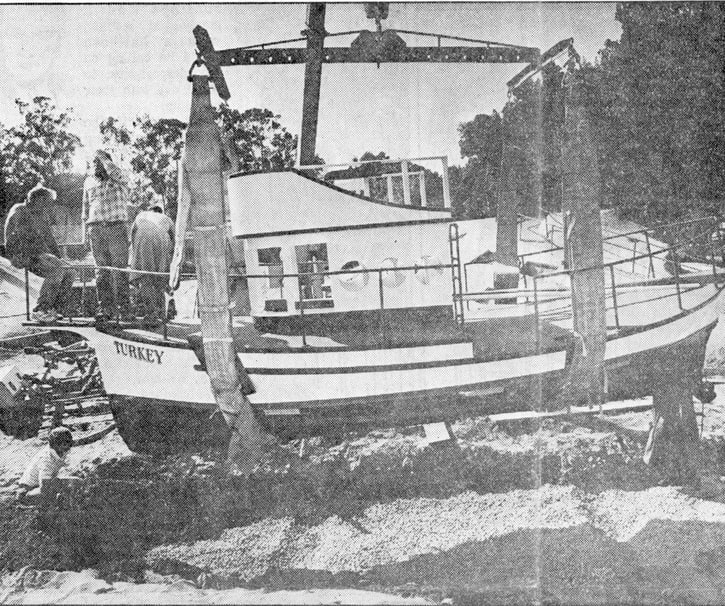 Freshly Rehabilitated Fishing Boat . . . rebuilt and installed at Dennis the Menace Park
Freshly Rehabilitated Fishing Boat . . . rebuilt and installed at Dennis the Menace Park
The Herald
Monterey CA Tuesday October 20, 1987 – Page 15
Fishing Boat Finds Berth at Park
Boat is Joint Project of Jaycees, City, Boat Works
By Calvin Demmon, Herald Staff Writer
A trim little fishing boat that plied the waters of Monterey Bay for nearly 80 years found a new berth Monday in Monterey’s Dennis the Menace Park. The freshly-rehabilitated boat, anchored in gravel and sand, will be a featured attraction of the popular Monterey playground when it reopens early next year after extensive remodeling.
Children will be able to climb aboard the boat, explore its cabin, stand on its extended bow, or mount a ladder to the top where they will find a ship’s wheel at which they can dream of sailing the seas.
Rebuilding and installing the boat was a joint project of the Monterey Peninsula Jaycees, the city of Monterey, and Monterey Bay Boat Works.
Built in 1905
The boat, built in 1905 fell into disrepair as it aged and was finally pulled out of the water two or tree years ago, according to Mike Maiorana, owner of the boat works.
Monterey CA Tuesday October 20, 1987 – Page 15
Fishing Boat Finds Berth at Park
Boat is Joint Project of Jaycees, City, Boat Works
By Calvin Demmon, Herald Staff Writer
A trim little fishing boat that plied the waters of Monterey Bay for nearly 80 years found a new berth Monday in Monterey’s Dennis the Menace Park. The freshly-rehabilitated boat, anchored in gravel and sand, will be a featured attraction of the popular Monterey playground when it reopens early next year after extensive remodeling.
Children will be able to climb aboard the boat, explore its cabin, stand on its extended bow, or mount a ladder to the top where they will find a ship’s wheel at which they can dream of sailing the seas.
Rebuilding and installing the boat was a joint project of the Monterey Peninsula Jaycees, the city of Monterey, and Monterey Bay Boat Works.
Built in 1905
The boat, built in 1905 fell into disrepair as it aged and was finally pulled out of the water two or tree years ago, according to Mike Maiorana, owner of the boat works.
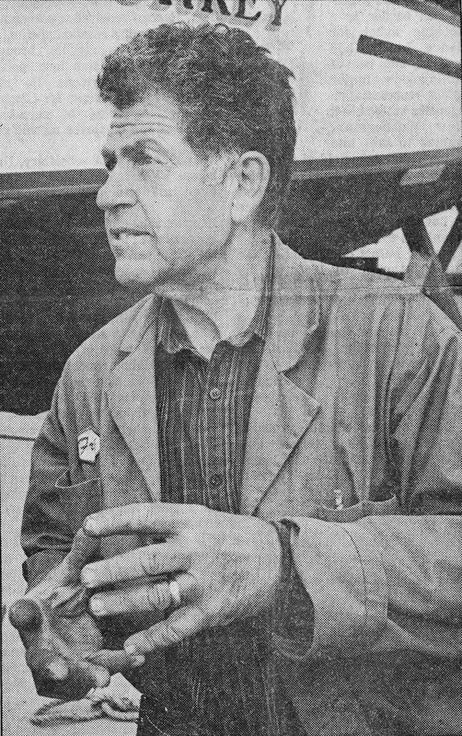 Shipfitter Frank Siino . . . a long history of boat building
Shipfitter Frank Siino . . . a long history of boat building
Maiorana said the boat probably had several names during its lifetime, but for its last years in the water it was known as the Turkey, and that’s the name it will carry into its new life in the playground.
Donated to the Monterey Parks Dept. by Greg Moore of Moss Landing, the boat has been restored to sparkling sturdiness by master craftsman Frank Siino, a fourth generation shipfitter whose family has a long history of boatbuilding in Monterey.
Siino 63, also built the Liboria, the fishing boat hanging inside the foyer of the Monterey Bay Aquarium.
Siino estimated he spent at least 600 hours working on the boat, beginning last March. The city and the JayCees paid for some of that time, the boat works paid for some of it, and Siino put in about 250 of those hours without pay, he said.
Maiorana said the city and Jaycees contributed $6,000 of the $12,000 to $15,000total value of the labor.
Also donating time to the project were Mike Palazola of Monterey, who welded the handrails; Kurt Every, who painted the name on the boat and Cal Garner of Carmel Valley, who transported the boat from Moss Landing to the boat works and then to the park.
Much of the 26-foot-long boat is new, including the deck and the cabin, Siino said, but some of the original keel and planking remain.
When the Turkey was built in 1905, it probably cost about $400 or $500, Siino said. Siino’s family which owned the original Monterey Bay Boat Works that is now the site of Stanford University’s Hopkins Marine Station, built hundreds of similar boats in the late ‘20s and early ‘30s for about $700 apiece, he said. Building a similar boat today would cost about $25,000.
A fishing boat like the Turkey would typically sail with a two man crew, and often with just one man aboard, Siino said. The Turkey was not a sardine boat, but a troller – after a good day of fishing, it would return with several hundred pounds of rockfish, salmon or albacore aboard,
“It’s a real boat,” Maiorana said. “It’s made a livelihood for a number of people over the years, and now the kids will have fun with it.”
Among those kids, Siino said, will be his own four grandchildren, ranging in age from 1 to 11 years old.
“Its just like we planned it,” he said, as he eyed the Turkey with a practiced eye after it had been gently lowered into place in the park. “The tilt is just right. I think it looks fine.”
Donated to the Monterey Parks Dept. by Greg Moore of Moss Landing, the boat has been restored to sparkling sturdiness by master craftsman Frank Siino, a fourth generation shipfitter whose family has a long history of boatbuilding in Monterey.
Siino 63, also built the Liboria, the fishing boat hanging inside the foyer of the Monterey Bay Aquarium.
Siino estimated he spent at least 600 hours working on the boat, beginning last March. The city and the JayCees paid for some of that time, the boat works paid for some of it, and Siino put in about 250 of those hours without pay, he said.
Maiorana said the city and Jaycees contributed $6,000 of the $12,000 to $15,000total value of the labor.
Also donating time to the project were Mike Palazola of Monterey, who welded the handrails; Kurt Every, who painted the name on the boat and Cal Garner of Carmel Valley, who transported the boat from Moss Landing to the boat works and then to the park.
Much of the 26-foot-long boat is new, including the deck and the cabin, Siino said, but some of the original keel and planking remain.
When the Turkey was built in 1905, it probably cost about $400 or $500, Siino said. Siino’s family which owned the original Monterey Bay Boat Works that is now the site of Stanford University’s Hopkins Marine Station, built hundreds of similar boats in the late ‘20s and early ‘30s for about $700 apiece, he said. Building a similar boat today would cost about $25,000.
A fishing boat like the Turkey would typically sail with a two man crew, and often with just one man aboard, Siino said. The Turkey was not a sardine boat, but a troller – after a good day of fishing, it would return with several hundred pounds of rockfish, salmon or albacore aboard,
“It’s a real boat,” Maiorana said. “It’s made a livelihood for a number of people over the years, and now the kids will have fun with it.”
Among those kids, Siino said, will be his own four grandchildren, ranging in age from 1 to 11 years old.
“Its just like we planned it,” he said, as he eyed the Turkey with a practiced eye after it had been gently lowered into place in the park. “The tilt is just right. I think it looks fine.”
